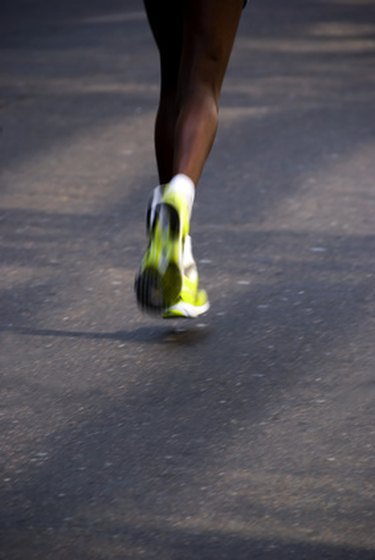
The Achilles tendon is the largest tendon found in the body and can hold pressures of more than 1,000 lbs., according to the American Orthopedic Foot and Ankle Society. It is located in the back of the heel and connects the heel bone to the muscles of the calf. Sometimes, overuse from running can cause the tendon to become inflamed, resulting in Achilles tendinitis.
Cause
Video of the Day
Achilles tendinitis can occur for several different reasons including overuse, increasing mileage or speed too quickly while running, climbing stairs, running hills, starting off too fast after a layoff, sprinting, tight muscles in the calf, heel spurs, inadequate stretching prior to exercise, improper warm-up prior to exercise, trauma to the tendon, flat arches and wearing shoes without enough support.
Video of the Day
Types
There are two types of Achilles tendinitis: noninsertional and insertional. Noninsertional Achilles tendinitis occurs when the middle of the tendon tears and becomes inflamed. It typically occurs in active, young individuals. Insertional Achilles tendinitis affects the lower portion of the tendon that attaches to the heel. This type can occur in anyone, even people that are not physically active.
Symptoms
Symptoms include heel pain that is worse with activity, heel pain in the morning, heel pain after running, stiffness of the Achilles tendon, swelling in the back of the heel and decreased range of motion of the foot. If you feel a popping sensation in the back of the heel, you may have ruptured the tendon.
Treatment
Achilles tendinitis will usually heal on its own with conservative treatment at home, although it may take some time for the pain to subside. Treatment should be started right away. The American Academy of Orthopedic Surgeons notes that it may take three months or more for pain to subside, even if treatment is started right away. Recovery time can even take as long as six months if treatment is postponed for several months. The first thing you must do is to rest the injured foot. Do not do any activities that make the pain worse, especially high impact activities such as running. Instead, try doing low-impact activities such as walking, biking, elliptical machines and swimming. Apply ice to the Achilles tendon for 20 minutes several times a day. This will help reduce pain and swelling. Nonsteroidal anti-inflammatories such as ibuprofen will help decrease pain and swelling as well.
Expert Insight
See your doctor immediately if you experience severe pain in the heel, are unable to bear weight on the foot or cannot push up on your toes or push your foot down.
Prevention
To avoid Achilles tendinitis in the future, gradually increase the intensity of your running routine, avoid activities that exacerbate pain, wear appropriate running shoes, stretch before and after running, warm up properly before stretching, do exercises that build calf muscles and try cross-training by alternating running with low-impact exercises to reduce the amount of stress on the tendon.
Is this an emergency? If you are experiencing serious medical symptoms, please see the National Library of Medicine’s list of signs you need emergency medical attention or call 911.